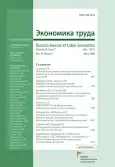GROW ROST: how to ensure productivity growth to the second power
- Authors: Volodyko A.K.1
-
Affiliations:
- National Research University Higher School of Economics
- Issue: Vol 10, No 7 (2023)
- Pages: 1019-1030
- Section: Articles
- URL: https://journals.eco-vector.com/2410-1613/article/view/607829
- DOI: https://doi.org/10.18334/et.10.7.118270
- ID: 607829
Cite item
Abstract
The article discusses the possibilities of the integrated application of the GROW coaching model and the ROST Automated Diagnostic Complex, developed on the basis of the All-Russian Research Institute of Labor of the Ministry of Labor of Russia. The study is based on the hypothesis that the integration of the ROST Automated Diagnostic Complex into the GROW model will allow managers to take a deeper look at the business development and improvement as well as at the goals that they set in working with personnel. The processes of identifying the potential for growth in company's efficiency and productivity were the object of the study. Diagnostic tools used in coaching sessions were the subject of research. Research methods are as follows: literary sources analysis, comparative analysis, a systematic approach, the method of induction in the formation of hypotheses and the synthesis of proposals according to the results of the conducted research. The author describes a possible method of applying the ROST Automated Diagnostic Complex in business coaching sessions. The practical application of this technique will improve the efficiency of coaching, and, consequently, the company productivity. In addition, the application of the ROST Automated Diagnostic Complex in connection with the GROW model will provide a more extensive analysis of the factors that prevent the company from using the available resources at minimal costs, and will also allow finding more effective steps to implement the insights received into work. The novelty of the proposed solution is determined by combining academic approaches to labor productivity management with modern coaching tools of an individual and business potential development.
About the authors
Alisa Konstantinovna Volodyko
National Research University Higher School of Economics
Email: aliswalk@gmail.com
References
- Голви Т. Работа как внутренняя игра. Раскрытие личного потенциала. - М.: МИФ, 2018. – 262 c.
- Голви Т. Внутренняя игра в теннис. - М.: Сэнтэ, 2008.
- Whitmore J. Coaching for Performance: Growing Human Potential and Purpose—The Principles and Practice of Coaching and Leadership. / 4th Edition, Nicholas Brealey Publishing. - London, 2009.
- Дж.Уитмор Коучинг Основные принципы и практики коучинга и лидерства. - М.: Альпина Паблишер, 2018. – 330 c.
- Дауни М. Эффективный коучинг: уроки коуча коучей. - М.: Добрая книга, 2013. – 288 c.
- Pullen B., Crane E. Creating a Coaching Culture in a Global Organisation // The International Journal of Coaching in Organisations. – 2011. – № 2.
- Griffiths B., Kaday C. Grow Your Own Carrot - Stop Struggling and Start Succeeding. - C.: Personal Solutions Publishing, 2004. – 214 p.
- Maxwell A. How do business coaches experience the boundary between coaching and therapy/counselling? // Coaching: An International Journal of Theory, Research and Practice. – 2009. – № 2 (2). – p. 149-162.
- Аткинсон М., Чоис Т. Рае Наука и искусство коучинга: Внутренняя динамика. - К.: Companion Group, 2009. – 208 c.
- Parsloe E., Leedham М., Newell D. Coaching and Mentoring: Practical Methods to Improve Learning. - London: Kogan Page, 2000. – 193 p.
- Дроздов И.Н. Консалтинг, коучинг, тренинг: теория и практика поддержки малого и среднего предпринимательства. - М.:Первое экономическое издательство, 2020. – 120 c.
- Модель GROW: польза коучинг-техники. Директор по персоналу: практический журнал по управлению человеческими ресурсами, 22.07.2020. [Электронный ресурс]. URL: https://www.hr-director.ru/article/67069-model-grow-polza-kouching-18-m3 (дата обращения: 30.09.2022).
- Сладкова Н.М., Ильченко О.А. Рост: эффективный инструментарий оценки барьеров и определения драйверов производительности труда // Социально-трудовые исследования. – 2020. – № 1(38).
- НИР «Разработка методики формирования опережающих показателей эффективности внутриорганизационных факторов». Рег. № НИОКТР АААА-А18-118083090022-6. ФГБУ «ВНИИ труда» Минтруда России, 2018 г
- Cusolito A. P., William F. M. Productivity Revisited. - Washington : International Bank for Reconstruction and Development / The World Bank, 2018. – 203 p.
- Кравченко А.И. Классики социологии менеджмента. / Ф. Тейлор и А. Гастев. - СПб, «Русский Христианский Гуманитарный Институт», 1998. – 95 c.
- Голдрат Э., Кокс Дж. Процесс непрерывного совершенствования. - М.:Поппури, 2009. – 496 c.
- Адизес И. Управление жизненным циклом корпорации. - СПб.: Питер, 2007. – 384 c.
- Альтшулер Г.С. Найти идею: Введение в ТРИЗ - теорию решения изобретательских задач. - М.: Альпина Паблишер, 2017.
- Visualize The Global 500. [Электронный ресурс]. URL: https://fortune.com/global500/2019/visualizations/ (дата обращения: 16.06.2022).
- Королихин А. В. Методология коучинга и его системная роль в поле помощи и развития // Коучинг: методология, научные основы и профессиональная этика: Сб.докладов Научно-практической онлайн-конференции Ассоциации русскоязычных коучей, Москва, 14.11.2020 года / Отв. за выпуск Л.М. Валиуллина, Н.В. Вострухина. – Москва: Знание-М. Москва, 2020. – c. 69-81.
- Дорошук А.А., Грациотова А.А. Методические подходы к оценке готовности при управлении изменениями на предприятии // Бизнес информ. – 2016. – № 10 (465).
- Голубенко О.А. Системный коучинг в ПТС: Краткий курс лекций для обучающихся 3 курса направления подготовки 27.03.02 Управление качеством. / ФГБОУ ВО Саратовский ГАУ. - Саратов, 2018. – 70 c.
Supplementary files











